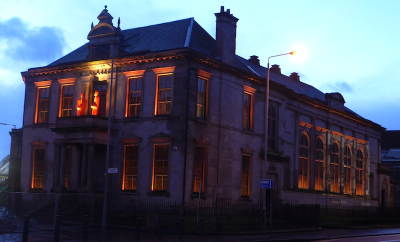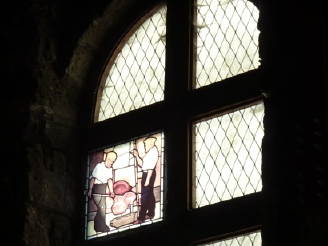Maryhill Burgh Halls
 In two previous articles from 2006 and 2007, historian Ian R Mitchell described the industrial heritage of Maryhill Unlocking Maryhill, and focussed on the campaign to raise funds to restore the historic Maryhill Burgh Halls buildings on Gairbraid Avenue, Maryhill, and bring back some of the unique stained glass panels created for the halls by Stephen Adam in 1878. Now Gordon Barr, the Heritage Development Officer for the Maryhill Burgh Halls Trust, brings the story up to date.
In two previous articles from 2006 and 2007, historian Ian R Mitchell described the industrial heritage of Maryhill Unlocking Maryhill, and focussed on the campaign to raise funds to restore the historic Maryhill Burgh Halls buildings on Gairbraid Avenue, Maryhill, and bring back some of the unique stained glass panels created for the halls by Stephen Adam in 1878. Now Gordon Barr, the Heritage Development Officer for the Maryhill Burgh Halls Trust, brings the story up to date.
Since Ian's articles were written, there has been a huge amount of progress on the project.
The Maryhill Burgh Halls were built in 1878, by Glasgow-based architect Duncan McNaughton. The complex of buildings originally featured the Halls themselves, an adjoining police station and fire station buildings, plus a tenement above in which the firemen lived. After the Burgh of Maryhill became part of the City of Glasgow, swimming baths and washhouses were added to the west of the site. The buildings themselves are handsome additions to the streetscape (and are now a mixture of Category B and C-listed buildings), but what makes the site completely unique is the survival of twenty stained glass windows that were commissioned for the building, and created by Stephen Adam in the late 1870s.
These panels show the huge variety of the trades, industries and occupations that were going on in Maryhill at the time. The panels are quite unstylised compared to most other stained glass of the time, and show ordinary people going about their everyday work. The amazing level of detail provides a fascinating record of fashions, tools, techniques, safety equipment, social attitudes - the designs were clearly made by watching real people working. The specific location of many of the panels can be worked out by looking at which industries were where in the area at the time - for example, the Boat Builder panel is located on the canal at Kelvin Dock, owned by the Swan family. Others can be located thanks to details like church spires or other background details, and in a few, educated guesses can even be made as to the actual identities of some of the people portrayed (in the Teacher panel, for example, the gentleman in question was likely John Russell, parish teacher and session clerk).
These glass panels were removed from the building for safe keeping in the 1960s, and placed in storage in the collections of Glasgow Museums, and have rarely been seen by the public since.
Discussions as to how best to develop the site, both to provide useful and financially viable and self-supporting community resources, and to ensure the retention and restoration of this complex of historic architecture, involved a wide range of consultations. The Trust held a number of extensive community engagement exercises, to see what local residents wanted done with the building, and what services they would use were it to re-open.
A programme of stonework and masonry repairs took place in 2008 to stabilise the structure and make sure it didn't deteriorate further while the fundraising campaign was ongoing. To highlight the developments at the site, a lighting project was instigated, to make the derelict building an unmissable landmark at night, with changing colours and a selection of images of the stained glass panels projected onto the side of the Hall. Two 'Journeymen' - enormous red fibreglass figures (originally created for the City of Architecture year in 1999 to highlight derelict and forgotten spaces in Glasgow) stood guard on the balcony.
 After over five long years of campaigning, the final pieces of the 9.2 million funding package fell into place in the Autumn of 2009, with the granting of 1.8M from the Scottish Government Town Centre Regeneration Fund. Other key funders include Scottish Government City Growth and Housing & Regeneration Division funds, the Heritage Lottery Fund, the Big Lottery (Growing Community Assets) Fund, the European Regional Development Fund, Historic Scotland, the Robertson Trust, and Glasgow City Council's Better Glasgow and Vacant and Derelict Land funds.
After over five long years of campaigning, the final pieces of the 9.2 million funding package fell into place in the Autumn of 2009, with the granting of 1.8M from the Scottish Government Town Centre Regeneration Fund. Other key funders include Scottish Government City Growth and Housing & Regeneration Division funds, the Heritage Lottery Fund, the Big Lottery (Growing Community Assets) Fund, the European Regional Development Fund, Historic Scotland, the Robertson Trust, and Glasgow City Council's Better Glasgow and Vacant and Derelict Land funds.
Project partners include Maryhill Housing Association, Cube Housing Association, and Glasgow City Council.
In November 2009, ownership of the Halls, Police and part of the Fire Station buildings were transferred from the Council to the Maryhill Burgh Halls Trust. Glasgow City Council retained ownership of the former baths, and under a separate project, have created a brand new modern leisure centre for Maryhill, behind the retained stone facade of the original building. This opened in mid-April 2010, and provides a swimming pool, sports hall, dance studio and other facilities for the area: http://www.csglasgow.org/services/Sport/GlasgowClub/Centres/Maryhill/.
The entrance to the leisure centre is through a new courtyard formed where the old Fire station buildings were; this will eventually provide a single central entrance to the entire complex of buildings once the Burgh Halls re-open next year. The frontage of the fire station has been kept, creating four arched entrances to this courtyard. To tie its new use into what used to be there, sculptor Andy Scott (creator of the Heavy Horse, the Shipbuilders and forthcoming Bigman sculptures, amongst many others) was commissioned to produce four landmark gates for this entrance, featuring firemen in their traditional uniforms, with period equipment and engines. Three of these can now be seen on site, and the fourth will be installed once building works on the Burgh Halls nears completion.
Once finished, upon entering the Halls complex from the courtyard, you'll find a spacious, two-storey cafe area, and a series of museum-quality displays and artefacts about the history of Maryhill, focussing on the unique stained glass panels and the trades and occupations they represent. Funding has now been secured to properly conserve the stained glass, which should allow us to display a number of the original panels within the restored Halls, giving visitors a chance to examine them in their original setting. It's hoped to have a number of panels on display, and to be able to rotate them over time, giving them a chance to return home to Maryhill over the next few years.
The main Hall will feature displays of the stained glass panels, and offer a modern and flexible sound and lighting system, with the ability to be laid out in a number of configurations for different types of events. Both commercial and community-based recording studios are also on-site, along with a nursery for up to 40 children, and a selection of offices and meeting rooms available for rent to local businesses and other organisations. All of this is wrapped around an outdoor garden courtyard area.
The completed complex of buildings will involve a mixture of the old (the restored Hall itself and the street facades of the Police and fire station) as well as new modern buildings added to the site behind to create new flexible space, designed by JM Architects.
 Since starting work on-site in November 2009, a huge amount of progress has been made. The older outbuildings to the rear of the site have been demolished, as has the bulk of the former police station. Its retained street frontage is currently supported by temporary props until the structural steelwork for the new replacement buildings behind is attached to support it. When the demolition works were completed, work started on preparing the ground for the new buildings. The new steelwork for these arrived in early May, and very quickly took shape on site. Inside the main Hall itself, new steelwork has been erected inside the original stone walls to help support a new floor to be added at roof level. In the front section of the building, facing down Maryhill Road, temporary props that have been helping hold the roof in place have been removed now that the rotten rafters have been strengthened.
Since starting work on-site in November 2009, a huge amount of progress has been made. The older outbuildings to the rear of the site have been demolished, as has the bulk of the former police station. Its retained street frontage is currently supported by temporary props until the structural steelwork for the new replacement buildings behind is attached to support it. When the demolition works were completed, work started on preparing the ground for the new buildings. The new steelwork for these arrived in early May, and very quickly took shape on site. Inside the main Hall itself, new steelwork has been erected inside the original stone walls to help support a new floor to be added at roof level. In the front section of the building, facing down Maryhill Road, temporary props that have been helping hold the roof in place have been removed now that the rotten rafters have been strengthened.
The whole building project is scheduled to be completed in May 2011.
The latest news and pictures about the project progress can be found on our website; along with detailed plans and information about the form of the finished complex of buildings and pictures of all of the stained glass windows. There is also a permanent exhibition on the project to be seen in Maryhill Library, and a large-scale model of the buildings can be found in the foyer of the new Maryhill Leisure Centre, next door to the Burgh Halls in Gairbraid Avenue.
As part of the project, we're keen to hear from as many people as possible - both current and former residents of the area! - who remember the Halls, have any recollections, stories, or photographs about visiting the Burgh Halls or any of the other buildings, and would be willing to share those memories. In particular, there are very few photographs showing the inside of the Halls, and we'd be extremely keen to see any that anyone might have hidden away in old albums or at the back of a drawer...
Part of the ongoing development plan is to establish a local history group to look into the history of Maryhill in general, beyond the Halls themselves, and build up an archive of local history material. Anyone interested in this project, or in finding out more details about the Burgh Halls or anything mentioned here is warmly requested to get in touch. You can do so either through leaving a comment below, or through the Trust website or contact: Gordon Barr
Gordon Barr
May 2010






